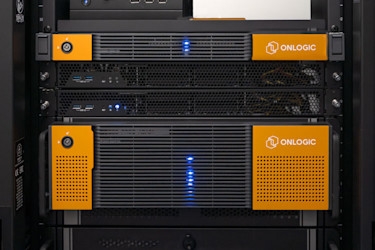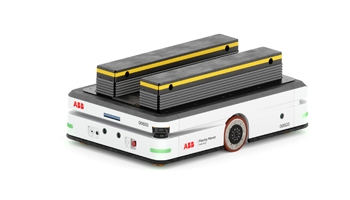The Ultimate Guide to Selecting an Edge Server

Answer these key questions to help right-size your edge computing infrastructure.
In today's data-driven world, the ability to process information at the source is more critical than ever. Edge servers are a key component to enabling on-premises and localized decision-making. But with a wealth of options available, choosing the right solution for your application can be a complex task. This guide, and its accompanying checklist, are designed to help you make an informed decision when selecting and configuring your edge server solution, so you can start making the most out of the data you're creating. By deploying computing power at the network edge, organizations can reduce latency, increase responsiveness, and better support applications that demand real-time action.
As part of a broader computing ecosystem, edge servers also play a central role in offloading demands on centralized cloud servers, improving user experience for latency-sensitive use cases.
What follows are the key questions you'll want to ask, and details you'll want to explore, to ensure you get the most out of your edge server hardware. Want a pared-down version of this guide easy reference? Download this checklist as a print formatted PDF.
https://www.onlogic.com/whitepapers/ultimate-edge-server-checklist/
What does the project require?
While it seems like a fundamental question, it's easy to conflate wants, such as "future proofing", with concrete needs, like the minimum acceptable latency for a sensor reading. The truth is that you'll need a perspective on both, but to effectively right-size your edge computing infrastructure the first step is to clearly define your project's application parameters and objectives, both for your immediate needs and any anticipated future requirements.
Begin by outlining the specific goals of your edge deployment. What problem are you trying to solve? What outcomes are you aiming to achieve? Clearly defining these objectives will lay the groundwork for determining the necessary performance levels, specifications, and features.
Consider the specific tasks the edge server will need to perform. For example:
- For AI and machine learning at the edge: What is the required inference speed (e.g., frames per second for object detection)? What level of model complexity will be involved?
- For data acquisition and aggregation: What is the volume and velocity of data streams you'll be processing? What are the real-time processing requirements?
- For industrial control: What are the latency requirements for control loops and communication with other devices?
For edge deployments in IoT-heavy environments, consider the scale of connected devices, sensor density, and the communication protocols required to manage data reliably. These edge devices may require intelligent routing, caching, or integration with mobile edge computing (MEC) platforms for performance scalability.
It's also important to define the function of each task clearly, whether that's interpreting sensor data, executing control logic, or managing device communications, so that hardware choices align with actual on-site roles.
Once you have a clear understanding of your application's objectives, it's helpful to explore if there are common industry benchmarks that correlate with your performance needs. For example:
- For general CPU performance: PassMark scores can provide a comparative measure.
- For object detection and other vision tasks: FPS (Frames Per Second) is a common metric.
- For machine learning inference performance: The MLCommons Inference Benchmark provides standardized evaluations across various models and hardware.
Identifying relevant benchmarks can help you translate your application's performance objectives into tangible hardware requirements, making the selection process more data-driven and efficient.
Specifically for edge servers, consider these additional application-level requirements:
- Real-time processing: Edge servers often need to process data with minimal latency to enable timely actions. This is critical in applications like autonomous vehicles, industrial control systems, and robotics, where even slight delays can have significant consequences. If your application has strict timing requirements, you'll need to consider hardware and software solutions designed for real-time performance. This often involves selecting an operating system capable of deterministic behavior, ensuring that tasks are completed within predictable timeframes.
- Security: Edge servers may handle sensitive data and are often deployed in less secure locations than traditional data centers, making robust security features essential. Beyond physical security, consider how you will remotely access and manage these distributed devices.
- Hardware-based security: Features like Trusted Platform Modules (TPM) and secure boot are crucial to protect against tampering and unauthorized access at the hardware level.
- Physical security: Depending on the deployment location, implement physical security measures such as locking port connections, port blocking bezels, locking panels, and intrusion detection.
- Remote access and manageability: For efficient management of geographically dispersed edge servers, consider systems equipped with a Baseboard Management Controller (BMC) featuring remote KVM (Keyboard, Video, Mouse) capabilities. This allows for out-of-band management, enabling remote troubleshooting, BIOS configuration, and OS installation even if the main system is unresponsive. On-premises edge systems often operate outside of centralized IT oversight, making embedded security features and remote management tools all the more critical.
- Orchestration: When deploying and managing a significant number of edge nodes, orchestration platforms become essential. Solutions like Zededa provide centralized management, application deployment, security policy enforcement, and monitoring across a distributed infrastructure, simplifying the operational complexity of large-scale edge deployments.
- Connectivity security: Carefully consider what other equipment the edge server will connect to and implement appropriate network security protocols.
- Data security: Determine where your data will reside and how it will be managed, implementing encryption both at rest and in transit as needed. Assess your network infrastructure to ensure it can support the addition of edge servers with appropriate security measures in place.
- Data filtering and aggregation: Will the server need to filter and aggregate raw data to reduce the amount of information sent to the cloud, to optimize bandwidth usage, and low latency, real-time systems like a smart city traffic management system? This capability reduces the burden on cloud computing resources and helps organizations maintain more predictable bandwidth usage. It can also support content delivery network (CDN) caching strategies at the edge to minimize load balancing overhead.
- Connectivity: What other equipment will the edge server connect to? Are there peripherals with specific connectors or systems requiring particular communication protocols (e.g., Ethernet/IP, Modbus, SFP modules)? Where will your data reside and how will it be managed, impacting network connectivity and storage needs?
Automation opportunities should also be considered early. Are there systems in place that require data offloading from machines to servers or between distributed edge cloud nodes to meet application SLAs? Additional information—like IEEE standards for industrial protocol support or Microsoft Azure edge or Amazon Web Services (AWS) integration options—may also shape which hardware or platform you choose.
What's the installation environment?
After defining the application and its requirements, determine where the edge server(s) will be deployed. This is a critical step, as the environment significantly influences the required level of ruggedization, reliability, and cooling.
A few of the key environmental factors to consider include:
- Extreme temperatures: Edge servers deployed outdoors or in industrial settings may be exposed to wide temperature fluctuations. Operating temperature ratings of components become critical to avoid failures and ensure reliable operation.
- Airborne particulates: Dust, dirt, and other contaminants can damage sensitive electronic components. Fanless designs are often preferred in industrial environments to prevent particulates from being drawn into the system.
- Vibration or shock: Edge servers installed in vehicles or near heavy machinery may experience significant vibration or shock. Ruggedized systems with vibration-dampening features and secure connections are necessary to prevent disconnections and hardware failures.
- Electromagnetic interference (EMI): Industrial environments often contain equipment that generates EMI, which can disrupt electronic devices. Shielded cables and enclosures are essential to protect the edge server from EMI and ensure reliable operation.
For edge servers in industrial settings like Manufacturing and Supply Chain & Logistics, consider these specific environmental factors:
New Whitepaper Coming Soon:
AI in Automation – Transforming Industry in 2025 and Beyond
 AI is no longer a promise for tomorrow—it’s driving measurable impact across manufacturing, logistics, robotics, and supply chains today. From predictive maintenance to generative design, AI technologies are optimizing operations, reducing downtime, and enabling smarter, faster decisions across the industrial landscape. In this newly expanded whitepaper, AI in Automation: Transforming Industry in 2025 and Beyond, the Association for Advancing Automation (A3) provides an in-depth roadmap to understanding, evaluating, and implementing AI in real-world industrial environments.
AI is no longer a promise for tomorrow—it’s driving measurable impact across manufacturing, logistics, robotics, and supply chains today. From predictive maintenance to generative design, AI technologies are optimizing operations, reducing downtime, and enabling smarter, faster decisions across the industrial landscape. In this newly expanded whitepaper, AI in Automation: Transforming Industry in 2025 and Beyond, the Association for Advancing Automation (A3) provides an in-depth roadmap to understanding, evaluating, and implementing AI in real-world industrial environments.
- Fanless design: In factories and warehouses, dust and debris are common. Fanless systems prevent these contaminants from being drawn into the server, improving reliability and longevity.
- Ruggedization: These environments can be harsh, with potential for vibration, shock, and temperature extremes. Ruggedized edge servers are built to withstand these conditions, minimizing downtime and maintenance.
In some cases, an additional enclosure may be practical, especially for outdoor installations or environments with extreme conditions. If using an enclosure, ensure adequate airflow and cooling to prevent overheating. Regardless of whether an enclosure is used, plan for how you'll mount or install the edge server, considering space constraints and accessibility for maintenance.
Translating requirements into technical specifications
This is often the first area of focus when scoping a technology project, but it's important to consider it within the context of the application requirements and the installation environment. The technical specifications determine the edge server's capabilities, performance, and compatibility.
Key specifications for edge servers include:
Processing: The CPU is a core component, especially for demanding edge computing tasks.
- For Artificial Intelligence and Machine Vision, consider processors with high clock speeds, multiple cores, and support for vector instructions (e.g., Intel AVX-512) or dedicated AI acceleration (e.g., Intel NPUs, NVIDIA GPUs).
- For simpler tasks like data aggregation or protocol conversion, a more energy-efficient processor might be sufficient (e.g., Intel Atom, low-power Intel Core).
I/O Ports: The number and type of input/output (I/O) ports determine how the edge server connects to other devices and networks.
- Ensure sufficient LAN ports for network, device, and machine connectivity, considering bandwidth requirements (e.g., 1 GbE for basic connectivity, 10 GbE or faster for high-bandwidth applications).
- Include USB ports for peripherals, serial ports (COM) for legacy industrial equipment, and video outputs (e.g., HDMI, DisplayPort) for local monitoring or visualization.
- For industrial applications, consider locking connections to prevent inadvertent unplugging, or rugged connectors like M12 for reliable connections in even more extreme environments.
Storage: Fast and reliable storage is essential for edge data processing and local data logging.
- Solid-state drives (SSDs), including those with wide operating temperature ratings, offer superior performance and reliability compared to traditional hard disk drives (HDDs), making them ideal for edge computing.
- Consider NVMe SSDs for faster access times.
- RAID configurations can provide data redundancy and fault tolerance, which is crucial for critical applications.
Memory: Adequate RAM is crucial for smooth operation, especially when multitasking, running multiple applications, or virtualizing workloads.
- The amount of RAM needed depends on the complexity of the tasks and the amount of data being processed.
- Error-correcting code (ECC) RAM is recommended for applications where data integrity is paramount.
Power: Ensure the edge server is compatible with the available power source, can handle power fluctuations, and can deliver the necessary wattage to components.
- Consider a wide input voltage range (e.g., 9-48V DC) for flexibility in industrial settings.
- Redundant power supplies can provide increased reliability.
- Be aware that GPUs can exhibit significant peak power draw, potentially reaching up to 2.5 times their specified thermal design power (TDP).
Wireless: If wireless connectivity is required, choose the appropriate technology and consider antenna placement.
- Wi-Fi is suitable for local wireless networks, while cellular connectivity (4G LTE, 5G) enables remote deployments.
- Bluetooth can be used for short-range communication with sensors or other devices.
- Plan antenna placement to ensure optimal signal strength and reliability.
- Utilize wide-temp Wi-Fi cards in extreme conditions to prevent connectivity drop-outs.
Operating System: Select an operating system (OS) that is compatible with your software and applications and meets your security and management requirements.
- Linux is a popular choice for edge computing due to its flexibility, open-source nature, and support for containerization.
- Windows may be required for specific applications or compatibility with existing systems.
For Machine Vision applications, also consider these particular specifications:
- GPU: For highly-complex vision workloads, a dedicated GPU can further accelerate image and video processing.
- Modern CPUs: While dedicated graphics accelerators have traditionally been the go-to option for machine vision solutions, modern CPU architectures, like Intel Core Ultra processors, can perform well on their own in many machine vision applications, extending system life while reducing cost and complexity.
- Camera Interfaces: Ensure compatibility with industrial cameras, considering interface types (e.g., GigE Vision, USB3 Vision) and the number of cameras to be connected.
What is the project timeframe?
A clear timeline is essential for ensuring your hardware provider can meet your project deadlines and avoid delays. Consider these factors:
- Prototype development and testing: Allow sufficient time for developing and testing a prototype to validate the hardware and software configuration.
- Rollout schedule: Plan the deployment schedule, considering the number of edge servers to be installed and the required installation time.
- Lead times and stock availability: Check the lead times for the selected hardware and ensure the vendor can provide the required quantity within your timeframe.
- Recurring orders and forecasting: If you anticipate recurring orders, provide your hardware vendor with forecasts to ensure they can plan their production and inventory accordingly.
- Component lifecycle: For long-term deployments, consider the lifecycle of the components used in the edge server to ensure availability and avoid obsolescence issues.
How many systems will you need, and for how long?
Inform your hardware vendor of your system quantity requirements and the timeframe to ensure adequate stock and minimize lead time issues. Recurring orders and accurate forecasting can help prevent backorders and component shortages.
For industrial applications like Manufacturing and Supply Chain & Logistics, component lifecycle is particularly important. Understand the lifecycle of your chosen system and its components to ensure long-term availability and avoid costly recertifications due to component changes.
What's the budget?
Budget is a key consideration in any project. While cost is important, it's crucial to weigh the total cost of ownership, including potential costs associated with downtime, maintenance, and future upgrades.
For example, in Manufacturing, downtime due to an edge server failure can cause significant production losses. Investing in reliable and redundant hardware can minimize these risks and provide a better ROI in the long run.
An experienced hardware vendor can help you find the right balance of cost and performance, suggesting solutions that meet your needs without unnecessary features or expenses.
What other services could be leveraged?
Explore additional services your vendor offers to streamline deployment, management, and support, potentially reducing your workload and internal costs. These may include:
- Hardware branding: Customizing the edge server with your company logo or colors for brand consistency.
- Custom labeling: Providing specific labels for identification and tracking of edge servers.
- Additional engineering support: Assistance with hardware customization, integration, or software configuration.
- Regulatory certifications: Ensuring the edge server meets relevant industry or regulatory standards.
- Direct shipping to end-users: Shipping edge servers directly to your customers or deployment locations.
Proactively identifying these needs early in the process can prevent delays and ensure a smoother project execution.
Choosing the right edge server involves a complex decision-making process. An experienced hardware partner can simplify the process and help you bring your project to life.
Ready to start building?
Our team of industrial computer specialists is ready to help you select and configure the perfect edge server for your project. Connect with our team today or visit our website to explore our entire catalog.
Keep these key considerations close at hand. Download our edge server selection quick-reference checklist.
https://www.onlogic.com/whitepapers/ultimate-edge-server-checklist/







Leave a Reply